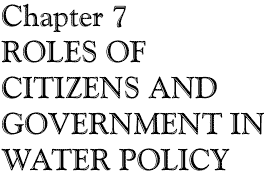
| ch. 7, pp. 99 - 100 |
Concerns about CAP outages due to drought or maintenance point to the need for some mechanism to enhance delivery reliability. This could be either storage at the end of the aqueduct (terminal storage) or an operational plan that could involve keeping a certain number of groundwater pumps ready to provide water in case of an emergency. Consideration of terminal storage has been delayed indefinitely as a result of Tucson’s decision to suspend direct delivery of CAP water. The draft Environmental Impact Statement relating to terminal storage estimated that Tucson would experience planned maintenance outages of five to 30 days per year. Emergency outages are projected at zero to three times every 10 years. These emergency outages could last up to two months. An emergency outage lasting 48 to 365 days could happen zero to two times every 50 years. Situated at the end of the canal, Tucson is in the position of having the least reliable CAP water supply. Terminal storage options include a 15,000 acre-foot above-ground reservoir, a 15,000 acre-foot per year underground storage and recovery facility, and installation of redundant features to minimize maintenance outages. Cost of the above-ground reservoir was estimated to be about $100 million. If built as part of the CAP, the costs would be borne by CAP water users in Pima, Maricopa and Pinal counties, with financing by the federal government at a 3.342 percent interest rate over a 50-year period. CENTRAL ARIZONA WATER CONSERVATION DISTRICT The Central Arizona Water Conservation District (CAWCD) is a state agency with the primary responsibility of managing the CAP. Voters in Maricopa, Pima and Pinal Counties elect board members generally based on population. The district is concerned with water fees and property taxes for CAP, water allocation, canal operation and maintenance. CAWCD is responsible for repaying CAP reimbursable construction costs to the federal government. The district also works with the Arizona Water Banking Authority and the Central Arizona Groundwater Replenishment District to implement CAP storage and recovery programs. Underground Water Storage, Savings, and Replenishment Program Administered by ADWR, the Underground Water Storage, Savings, and Replenishment Program (UWS) encourages the use and/or storage of renewable supplies, including CAP water. There are two types of facilities allowed under this program: Underground Storage Facilities and Groundwater Savings Facilities. Underground Storage Facilities (USFs) involve physical recharge of water through injection wells, infiltration basins, or natural watercourses. Water stored at these facilities can be designated for one of several uses: recovery in the same calendar year (annual storage and recovery), long-term recovery using storage credits, or not to be recovered at all. If the water is recovered, it does not have to be recovered in the same place as it was stored. However, recovery rules are designed to prevent recovery of water in areas where groundwater levels are substantially declining. Groundwater Savings Facilities (GSFs) usually involve farms which agree to use CAP water rather than pumping groundwater. GSFs are referred to as “in-lieu” recharge facilities because CAP water is used in lieu of groundwater, but GSFs do not involve physical recharge. In a typical GSF arrangement, an entity such as a municipal water provider sells CAP water to a farm, usually at a price lower than what the farm would pay to pump groundwater. In return, the state grants credits to municipal providers for the amount of groundwater that otherwise would have been used. The municipal provider can use these credits to offset pumping of groundwater in meeting ADWR conservation rules. A majority of the activity under the UWS program to date in TAMA has been through GSFs. Arizona Water Banking Authority Arizona cannot currently directly use all its allotted CAP water and does not expect to directly use the full allotment until the year 2030. Since California claims a right to take unused Colorado River water, Arizona has devised a way of keeping as much of it as possible in the state. The Arizona Legislature created the Arizona Water Banking Authority (AWBA) to acquire unused portions of Arizona’s allocation of Colorado River water and put it to use for storage underground or, in other words, to recharge it in central Arizona. AWBA is authorized to store water to meet one of four overall goals: to protect municipal uses from possible drought situations or CAP delivery interruptions; to meet Indian water rights claims; to meet local water management objectives; or to facilitate interstate water banking with California or Nevada. AWBA is funded using property taxes, groundwater withdrawal fees in counties with CAP water (Maricopa, Pinal and Pima counties) and money from the sta te’s general fund. AWBA does not construct recharge facilities, but uses recharge structures built by other entities, such as Tucson Water or CAWCD. The water flows through the CAP canal to the storage facility, and AWBA pays CAWCD for the water costs. AWBA participating entities then benefit by accruing credits for the water stored and by using the water when needed under certain conditions dictated by state law. Credits earned with money from the general fund are used to benefit cities, towns and water providers along the aqueduct. Water storage credits earned with money from groundwater withdrawal fees are to be used in the AMA where the fees were collected. Credits from the property tax accrue to CAWCD to meet demands of municipal and industrial customers when CAP supplies are interrupted.
|
